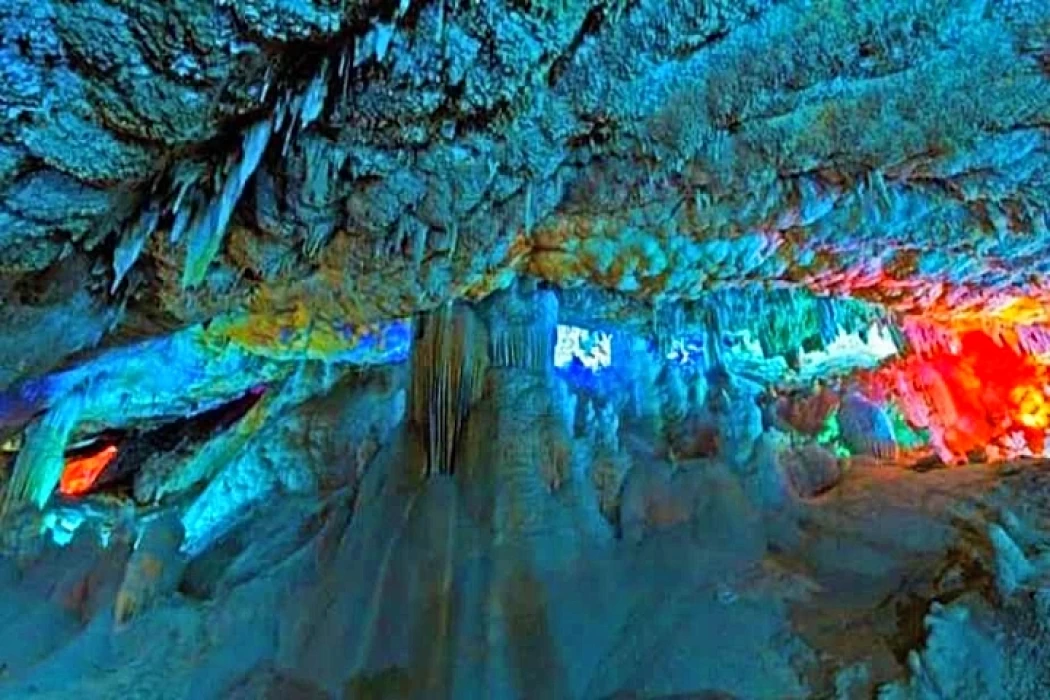
Sannur valley Cave protectorate
Sannur valley Cave protectorate
Senour Cave is a huge cave in the heart of the mountain with a depth of about 17 meters, this cave is located 70 km southeast of Beni Suef, and there are several quarries, including ancient ones that were discovered and exploited during the era of the pharaohs, and modern ones that are currently being exploited.
The stalagmites and stalactites of pure alabaster are distributed in a picturesque form, and in the floor of the cave in the eastern corner of it there is a waterway that falls below the level of the cave floor, which is believed to be a means of draining the water collected in the cave.
As a result of the continuous alabaster extraction operations, a large gap appeared in the bottom of the quarry 54, leading to an underground cave that extends a large area just below the operating interface, and contains geological structures known as stalagmites and stalactites in a perfect picture whose formation dates back to the Middle Eocene era, about 60 million years ago. The cave is about 700 meters long, about 15 meters wide and about 15 meters deep.
This reserve is characterized by the presence of geological structures known as stalagmites and stalactites of alabaster (calcium carbonate) in a perfect form formed over millions of years as a result of the leakage of water solutions saturated with calcium carbonate salts through the ceiling of the cave and then evaporated, leaving these mineral salts that accumulated.
The importance of this cave is due to the rarity of these natural formations in the world; they shed light on the conditions of the ancient climate in that region and the age of their formation. The importance of this cave is due to the rarity of these natural formations in the world, and they shed light on the conditions of the ancient climate in that region and the age of their formation.
The cave under consideration is geologically significant, mainly due to the scarcity of such natural features in the world, and it is of high value for researchers interested in carrying out in-depth comparisons and focusing on paleoclimatology and the characteristics of the ancient environment.
Also, it enables researchers to undertake detailed comparative studies concerning the contrasting ancient environmental conditions that existed during the Middle Eocene period. In view of the world scarcity of such natural formations, they hold great significance for the geologists to study differences in paleoenvironmental conditions existing during the Middle Eocene in great detail.
Latest Articles
Admin
Aswan Governerate in Egypt
Aswan was known as ‘Sonu’ in ancient Egyptian times, meaning market, as it was a trading centre for caravans coming to and from Nubia. In the Ptolemaic era, it was called ‘Sin’ and the Nubians called it ‘Yaba Swan’. It was also known as the Land of Gold because it served as a great treasure or tomb for the kings of Nubia who lived there for thousands of years. Before the migration, Aswan's borders extended from Asna in the east to the border of Sudan in the south, and its inhabitants were Nubians, but after the Islamic conquest of Nubia, some Arab tribes settled there.
Admin
About Luxor Governorate in Egypt
The South Upper Egyptian area is home to the Egyptian governorate of Luxor. Its capital is Luxor, which was formerly Thebes, the capital of Egypt throughout multiple pharaonic eras. Its centers and cities are spread over both sides of the Nile River. The said governorate was established by Presidential Decree No. 378 of 2009, which was promulgated on the 9th of December of that year.
Admin
History of kafr El Sheikh Governorate
Kafr El Sheikh Governorate, located in the far north of Egypt in the Nile Delta, overlooking the Mediterranean Sea, is characterised by the diversity of natural life and environments, and is one of the Egyptian cities that can be visited after the end of the first semester exams at universities and schools, as it features many diverse tourist and recreational places at symbolic prices within everyone's reach.
Admin
Egypt's New Administrative Capital
The New Administrative Capital is considered the project of the era because it reflects a perfect image of the future and progress on the economic, cultural, social and civilisational level, as the capital is considered the new capital of Egypt at the present time. The importance of the New Capital is that it is a comprehensive transformation of the future of buildings, services and national and mega projects in Egypt.
Admin
Al Gharbia Governorate
The Governorate of Gharbia is inclusive in the geographical area of The Arab Republic of Egypt which is in the African continent, more specifically in the region surrounding the Nile delta, between Damietta and Rashid governance. To the control of the region from the north is Kafr El-Sheikh Governorate, from the south Menoufia Governorate, from the east – Dakahlia, Qalyubia Governorates, and to the west is the Beheira Governorate.
Admin
Hamata Islands (Qulaan Archipelago) in Marsa Alam
Each reserve has several sectors. In Wadi El Gemal Reserve, there is one of the natural areas called the Hamata area or Hamata sector in Wadi El Gemal Reserve. Its sectors are the perfect and most ecological, land and water, and host countless animals and plants found in the oceans and on the land.













